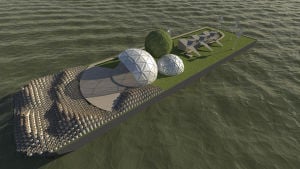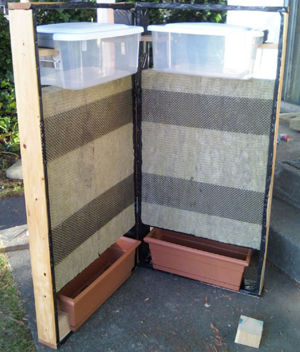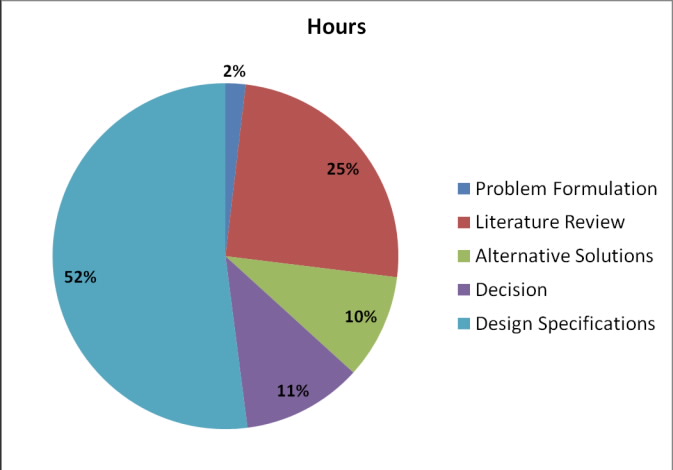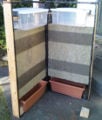CourtneyOto (talk | contribs) |
CourtneyOto (talk | contribs) |
||
| Line 189: | Line 189: | ||
== Specifications == | == Specifications == | ||
Technical specifications including a schematic (CAD, pictures of the device). | Technical specifications including a schematic (CAD, pictures of the device). | ||
Here is some [[Help:Contents#Uploading|help uploading files]]. | Here is some [[Help:Contents#Uploading|help uploading files]]. | ||
== Operation Instructions == | == Operation Instructions == | ||
Revision as of 03:34, 7 May 2009
Background

The Waterpod was created to demonstrate a possible way of future living through water based communities. These communities would be self sustaining and nomadic; allowing for growing populations to thrive in a highly innovative and more sustainable manner. As a way of inspiring innovation, the WaterPod contacted the Environmental Resources Engineering Department at Humboldt State University in order to have their Engr215 students design highly sustainable tools to be utilized on the pod.
Abstract

The Waterpod was created to demonstrate alternative living models for future living through water based communities. These communities would be self-sustaining and nomadic; allowing for growing populations to thrive in an innovative and more sustainable manner. As a way of inspiring innovation through sustainability, the Waterpod contacted our team, Green Apple, to design and build a simple hydroponics system that would be utilized on the pod for the six month period of their demonstration of self-sustainability. What resulted was the Hang Thyme hydroponics system; a hydroponic living wall that doesn’t require electrical energy. The living wall design is easy to build, implement, and maintain sustainable agriculture.
Objective & Criteria
The Waterpod project "embodies self-sufficiency and resourcefulness, learning and curiosity, human expression, and creative exploration. It intends to prepare, inform and provide current alternative future living sustainable space."
Objective
To design and build a specific, yet cost effective component for the Waterpod to help educate the community of New York move towards self-sustainability.
- Uses no electricity
- Demonstrates a "Do-It-Yourself" design project
- Conserves space
- Uses renewable/recyclable materials
- Effective healthy plant growth using no pesticides or chemicals
The Simple Hydroponic Living Wall system demonstrates an easy Do-It-Yourself project that shows the community/society to move towards a self-sustainable future. The system is easy and safe to use for an individual and prepares him/her for a futuristic ecology.
Criteria
| Criteria | Description | Weight |
|---|---|---|
| Cost | Cannot exceed the fixed budget of $300 | 10 |
| High Energy Efficiency | Cannot exceed the maximum energy allotment of 1 kW | 9 |
| Easy To Build/Maintain | A design that the average person could understand, implement, and maintain | 8 |
| Safety | A solid foundation and free of toxic materials | 7 |
| Durability | Must meet or exceed six months of use | 6 |
| Portability | Must be easily moved and maneuvered by a person | 5 |
| Maximize Growth Space | Must effectively grow produce in minimal space | 4 |
| Aesthetics | Must be visually attractive | 3 |
Cost & Materials
| Quantity | Material | Source | Cost ($) | Total ($) |
|---|---|---|---|---|
| 2 | Hinge Narrow 2" ZN CD/2 | Ace Hardware Store | 3.99 | 7.98 |
| 18 | Screw | Ace hardware Store | 0.10 | 1.80 |
| 2 | Corner Brace 2 x 5/8" | Ace Hardware Store | 3.99 | 7.98 |
| 1 | Film Poly Blk3mil 10 x 25' | Ace Hardware Store | 11.99 | 11.99 |
| 1 | Gutter Guard 6" x 20' Vinyl | Ace Hardware Store | 4.29 | 4.29 |
| 2 | Shellac Spray Clear 13 oz. | Ace Hardware Store | 9.49 | 18.98 |
| 1 | Catch Draw Lock 2- 1/2" zn | Ace Hardware Store | 5.99 | 5.99 |
| 1 | Staple 3/8" HD 1000 | Ace Hardware Store | 3.99 | 3.99 |
| 1 | Hinge Narrow NRP 3" zn | Ace Hardware Store | 4.99 | 4.99 |
| 4 | 12" Grodan Rockwool Slab | Local Hydroponics Store | 12.30 | 49.20 |
| 1 | Bath Caulk Silicon Rubb White | Ace Hardware Store | 5.99 | 5.99 |
| 1 | Box of Wood Screws 6 x 1-1/2 | Ace Hardware Store | 5.49 | 5.49 |
| 2 | Plastic 18 qt Container | Target | 4.99 | 9.98 |
| 2 | Terra-Plastic 20 in Flower Box | Target | 12.99 | 25.98 |
| 2 | Herb Seed Package | Target | 4.97 | 9.94 |
| 16 ft | 1' x 4" Douglas Fir Wood | Arcata Lumber | 6.93 | 6.93 |
| 1 | L Brackets 3 x 3/4 Cor Iron | Ace Hardware Store | 4.29 | 4.29 |
| 6 ft | 4 x 4 Douglas Fir Wood | Ace Hardware Store | 4.80 | 4.80 |
| Total Cost | $190.59 | |||
See this example of a cost table for more on tables.
Time Cost
The total time spent on this project between four people was 321 hours.

Tools
Tools used were:
- A power drill
- A box cutter
- A pair of wire cutters
- A staple gun
- A table saw
Project Requirements
The unique simple hydroponic design consisted of great ideas from each member as well as other countries that do not have the perfect weather, soil and resources for agricultural development. The though and motivation of the design implemented innovation and simple thinking. The aspect of creating and building the simple hydroponic design consisted of resources from books, world wide web, and from the help of the Water pod clients.
Our Goal of the design is to design a system that would use no electricity, use less water, and easy maintenance by using simple tools. In order to achieve our goal we communicated by collaborating with local hydroponic stores and system analysis through research. The design also focuses on changing the systems growth medium, and nutrient solutions based on the type of plants that will be used in the system.
Estimated time of construction
The total time of construction came to approximately 30 hours.
Specifications
Technical specifications including a schematic (CAD, pictures of the device). Here is some help uploading files.
Operation Instructions
- Remove the Rockwool slabs from the system and allow them to soak in the nutrient solution for 24 hours.
- With the unit flat on its back, the black mesh strips are on the ground reinsert the slabs into their original formation shown in Figure 3.
- When the slabs are in place, pull the unit up right and open it up until it’s approximately at a 90 degree angle and place the external support in the slot as seen in Figure 4.
- Insert the two nutrient reservoirs and the nutrient catchment systems as shown in Figure 5. The two top reservoirs can be inserted by lifting up on the wooden tab and sliding them into place.
- To plant seeds holes need to be drilled such that the seeds can be deposited. The depths will vary based on the choice of plant.
- Once the plants are in place the growth medium must be kept moist. This can be done by filling the two clear containers at the top with the nutrient solution. Pre-drilled holes will allow for the nutrient solution to trickle down onto the medium where it will be absorbed and transported throughout the medium via gravity.
- When the two lower containers become filled they can be removed and the nutrient solution can be recycled into the top containers.
- The watering schedule will vary based on climate conditions, however the medium should be kept moist at all times.
-
Figure 3: Reinserting Rockwool slabs.
-
Figure 4: External support in place.
-
Figure 5: Placement of nutrient reservoirs and catchments.
Next steps
Possible alternatives devices
Location
References
Books
Sholto,J. (1920) Hydroponics: The Bengal System With Notes On Other Methods Of Soilless Cultivation, R. Dayal, New Dehli.
Resh, M. (1978) Hydroponic Food Production, Woodbridge Press, Santa Barbara.
Watt, S.B. (1975). A Manual on the Hydraulic Ram for Pumping Water. London: Russel Press Ltd.
DeKorne, James B. (1992). The Hydroponic Hot House. Port Townsend: Loompanics Unlimited.
Kingsbury, N., Dunnet N. (2004). Planting Green Roofs and Living Walls. Portland: Timber Press Inc.
Tacke, J.H. (1988). Hydraulic Rams, A Comparitive Investigation. Delft, The Netherlands: Delft University of technology.
International Society for Pharmeceutical Engineering. (2000). Specifying Peristaltic Pumps. Wilmington: Watson-Marlow
Journals
Al-Jousi, Odeh R. (2003). “Greywater Reuse: towards sustainable water management.” Elsevier Science., 156(2003), 181-192.
Anslow, Mark. (2008). “Horticultural Capital.” Ecoligist, The 38:4:12-12.
Websites
Schmidt, J., Gerber, J., and Courter, J. “Hydroponics As A Hobby.” College of Agricultural, Consumer, and Environmental Sciences at the University of Illinois, <http://www.aces.uiuc.edu/vista/html_pubs/hydro/hydrotoc.html> (Feb. 22, 2009).
(2008). “Glossary Of terms.” Growing Edge, <http://www.growingedge.com/basics/glossary.html> (Feb. 23, 2009).
(2007). “Tips On Making Your own Hydroponics System.” The Hydroponic Garden, <http://www.peterjonesweb.com/hydroponics/tips_on_making_your_own_hydroponics_system.html> (Feb. 22, 2009).
(2003). “Growing Mediums.” Hydro empire, <http://www.hydroempire.com/store/growing_mediums.php> (Feb. 20, 2009).
(2008). “Growing Medium. “ Simply Hydro, <http://simplyhydro.com/growing1.htm> (Feb. 23, 2009).beconrad. “Increase Your Hydroponics Success with the Right Plants.” Hydroponics Search, <http://www.hydroponicsearch.com/index.php?option=com_content&task=view&id=664&Itemid=99999999> (Feb. 19, 2009).
“Hydroponic Systems.” Online Image. 2008. Simplyhydro.com. February 17th 2009. < http://simplyhydro.com/system.htm> USGS Georgia Water Science Center (2006). “Hydrology Primer.” <http://ga.water.usgs.gov/hydroprimer.html> (Feb. 26, 2009).
Pushard, Doug (Feb. 2009). “Is Rainwater Really Safe- One sample Case.” <http://www.harvesth2o.com/rainwater_safe.shtml> (Feb. 26, 2009).
Koch Membrane Systems Inc. (2008). “Comparing Waste Water treatment Technologies.” <http://www.kochmembrane.com/mbr_basics.html> (Feb. 26, 2009).
Texas A&M, Agri Life Extension (2009). “Rainwater Harvesting.” <http://rainwaterharvesting.tamu.edu/rainwaterbasics.html> (Feb. 26, 2009).
ASCE Research Library (1993). “The Maya: America’s First Water Resources Engineers.” <http://cedb.asce.org/cgi/WWWdisplay.cgi?0702126> (Feb. 26, 2009).
Categories
<layout name="AT device" />



